
 So, okay. I went out yesterday to check out the nature trails behind UNC’s botanical garden, for the first time in over a decade. You’d like to think that nature photographers are always in touch with every natural area nearby – and they probably are… it’s just that I’m not. Actually, I have several other areas that I prefer, mostly well away from people, also able to produce more interesting critters, but yeah, I probably should have been back sooner than this.
So, okay. I went out yesterday to check out the nature trails behind UNC’s botanical garden, for the first time in over a decade. You’d like to think that nature photographers are always in touch with every natural area nearby – and they probably are… it’s just that I’m not. Actually, I have several other areas that I prefer, mostly well away from people, also able to produce more interesting critters, but yeah, I probably should have been back sooner than this.
Anyway, since this was intended just as a scouting session, with no real goals in getting any images, it makes perfect sense that I shot close to 400 frames – which is more than I’ve taken many times when specifically going out to produce usable photos. This is one of the reasons I encourage taking your camera (a real one) with you as often as possible. The fall colors have not ‘peaked’ yet, but the trees tend not to coordinate amongst themselves very well and all peak at different times, so creating autumn compositions can be done for weeks. Meanwhile, there’s this little layout rule that images alongside text should be oriented so that they pull attention into the text – if there’s an implied direction or natural emphasis, it should be towards the printing and not off the page. The only thing is, with this forest steps shot, I’m not sure which way that actually is…
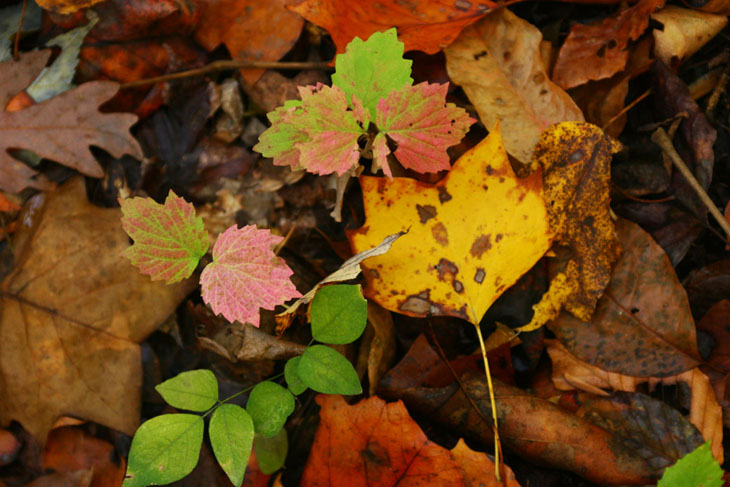
It somehow doesn’t seem right that a sapling that’s only achieved ankle height should be turning, about to lose its leaves, but then again, why wouldn’t it? I liked the variety of leaves that could be seen in such a small area, as well as the pleasantly contrasting pink and green of the little sprout.
 The sky was perfectly clear after the previous day’s rain storms, and the low angle of the wintering sun produced not only very high contrast conditions, but a significant amount of glare when facing anywhere remotely eastward, so some compositions, that might have been quite compelling in other conditions, were simply out of the question. There are ways, however, of using such light angles. Magnolia trees tend to lose their leaves early, and the bigleaf magnolia (Magnolia macrophylla) wasn’t far from dropping these like so many of the others already littering the ground beneath, so within a few days this opportunity would have been gone. Some trees are already bare and many in the process of changing colors, while quite a few, as seen in the steps shot, are still quite green.
The sky was perfectly clear after the previous day’s rain storms, and the low angle of the wintering sun produced not only very high contrast conditions, but a significant amount of glare when facing anywhere remotely eastward, so some compositions, that might have been quite compelling in other conditions, were simply out of the question. There are ways, however, of using such light angles. Magnolia trees tend to lose their leaves early, and the bigleaf magnolia (Magnolia macrophylla) wasn’t far from dropping these like so many of the others already littering the ground beneath, so within a few days this opportunity would have been gone. Some trees are already bare and many in the process of changing colors, while quite a few, as seen in the steps shot, are still quite green.
I have to note, with pleasant surprise, that the number of longneedle pines to be seen in these woods is quite low – they’re an ugly tree, and quite a pain in the ass in that their needles get everywhere, all year long, and the ground cover they produce tends to prevent many other plants and trees from getting started. It’s nice to see a greater variety, and of course the deciduous trees make for better photo subjects, even when dead.
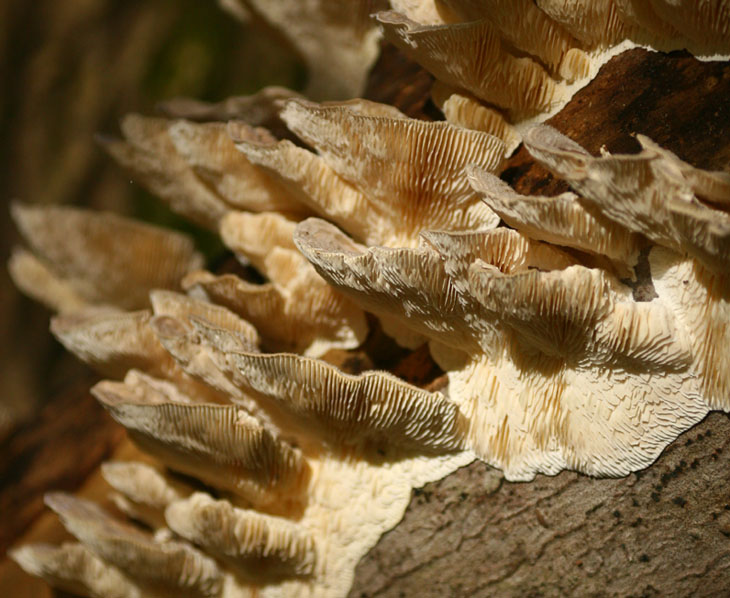
Part of the reason these details can be seen so distinctly is because of that bright, low sun, and with the forest canopy, the opportunity for the light to shine through is sporadic – thus, this was as much a matter of opportunistic timing as any ability to spot something interesting. It might also have been interesting still dripping with rain – it helps to think of variations that might occur, so you can plan and seek out certain shots when the conditions are right.
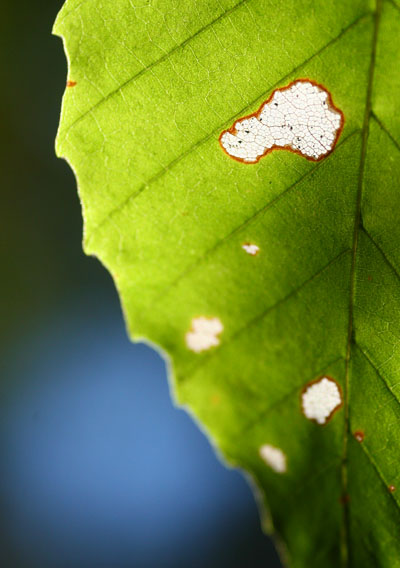 Background is an important factor, and one that is amazingly easy to change at this time of year. A very small adjustment of shooting position – left or right, higher or lower – can drastically affect just what is going to appear in the background, and the ability to enhance your subject can make the difference between a basic shot and an interesting one. Is there a color or shape that will work with the subject better? Is there something clashing that needs to be eliminated? Thinking in terms of the entire frame, and being aware of what’s beyond the subject, can help a lot. While this one was relatively simple to achieve, I’ve gone flat on the ground or stood on fences and rocks to change the appearance of the background (and affect the light angle as well) – minor efforts to create major differences. And yes, this has often meant getting dirty, damp, or worse, and sometimes I bring along kneepads and a ground cloth (a small section of waterproof tarp) when I expect to be doing a lot of it, but I’m also not too concerned with how I look to others, or how uncomfortable I might be afterwards, if I get a shot that I like.
Background is an important factor, and one that is amazingly easy to change at this time of year. A very small adjustment of shooting position – left or right, higher or lower – can drastically affect just what is going to appear in the background, and the ability to enhance your subject can make the difference between a basic shot and an interesting one. Is there a color or shape that will work with the subject better? Is there something clashing that needs to be eliminated? Thinking in terms of the entire frame, and being aware of what’s beyond the subject, can help a lot. While this one was relatively simple to achieve, I’ve gone flat on the ground or stood on fences and rocks to change the appearance of the background (and affect the light angle as well) – minor efforts to create major differences. And yes, this has often meant getting dirty, damp, or worse, and sometimes I bring along kneepads and a ground cloth (a small section of waterproof tarp) when I expect to be doing a lot of it, but I’m also not too concerned with how I look to others, or how uncomfortable I might be afterwards, if I get a shot that I like.
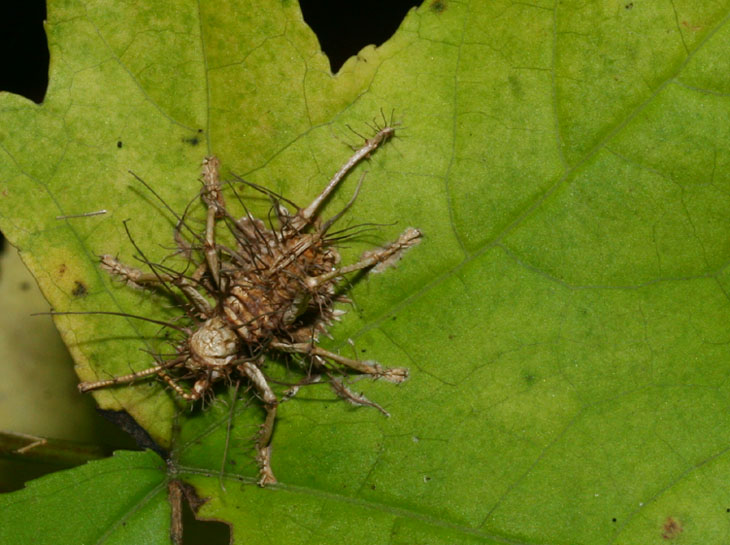
I wasn’t loaded for doing elaborate macro work, but I kind of wish I’d tackled this one in greater detail. While any insect that dies might serve as food for opportunistic fungi, there are varieties that actually infect living species and provoke them towards certain behaviors that will promote the spread of their spores – the same can be said for many parasitic microbes, and I’ve had such images on my mental shooting list for years. From, really, not very far away, this just appeared to be a whitish cricket perched on a leaf, but up close it gets supremely creepy (okay, even creepier than many of my images.) So, yeah, Happy Halloween again.
 I decided, since i was in the immediate vicinity, to hit the garden proper once more. North Carolina is one of the few states where predatory plants are native, so the botanical garden, dedicated to native species, features a variety of Venus flytraps, sundews, and pitcher plants. The pitcher plants always host some resident wasps, and I’m in the process of determining what these are and how they live. The reason being, I’ve seen more than a few pitcher plants that are plugged with grass or leaves, and some that feature a hole chewed into the trumpet well down the body. Pitcher plants have slippery insides, an attractive smell, and a pool of sticky nectar at the bottom that attracts the insects that will nourish the plant with their death, but it appears some arthropod has circumvented this trait for their own purposes, probably in protecting the larvae. Right now I’m just not sure if it’s actually the wasp species seen here, or of the wasp preys on the species that attacks the pitcher plant. So I’ll just leave this image here while I work on the details.
I decided, since i was in the immediate vicinity, to hit the garden proper once more. North Carolina is one of the few states where predatory plants are native, so the botanical garden, dedicated to native species, features a variety of Venus flytraps, sundews, and pitcher plants. The pitcher plants always host some resident wasps, and I’m in the process of determining what these are and how they live. The reason being, I’ve seen more than a few pitcher plants that are plugged with grass or leaves, and some that feature a hole chewed into the trumpet well down the body. Pitcher plants have slippery insides, an attractive smell, and a pool of sticky nectar at the bottom that attracts the insects that will nourish the plant with their death, but it appears some arthropod has circumvented this trait for their own purposes, probably in protecting the larvae. Right now I’m just not sure if it’s actually the wasp species seen here, or of the wasp preys on the species that attacks the pitcher plant. So I’ll just leave this image here while I work on the details.
I just want to point out: dark green, behind the wasp. A slight shift in either direction would have changed the background color, and thus how well the wasp stood out.
I kept my eyes open when I approached the small pond which held my subject from an earlier visit, and the attention paid off – this is quite likely the same green frog (Rana clamitans,) though I spotted no tadpole this time.
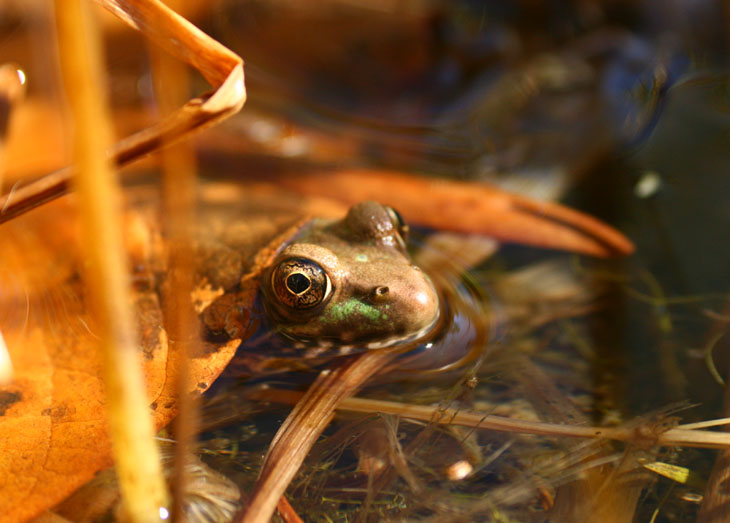
Moving slowly, I was able to actually prop my elbows on the rim of the pond for a tight portrait, a much more personable angle than the previous images of this amphibian – and one that produced a subtle but interesting addition. It’s not hard to make out the reflections of the foreground reeds in the frog’s eye, but there’s something else too, which we’ll go a little closer to make out.
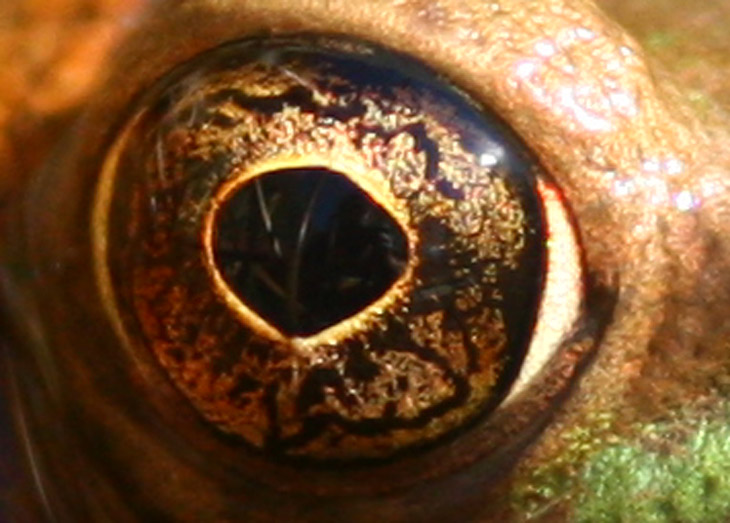
This is slightly better than twice full resolution. To the right, you can actually see the barest reflection of me getting this shot; my sidelit forehead is showing near the top under the blue sky, while my right hand can be made out on the shutter, and the faint curve of my left hand under the lens. The camera, black and facing away from the light, is only visible as a dark space. Now I’m going to have to try for a better version of this…
 I also got another image of the same flowering plant that appeared in that earlier post, though not the same blossoms of course. This time I was thoughtful enough to look for the identifying plaque, but there was none, so I still cannot tell you what species this actually is. But the light was at a more useful angle this time, so the interiors were better illuminated, meaning that one of the bumblebees had to burrow in quite deeply to stay in the shadows – that dark spot in the lower blossom is a bee, while the other scampered around on the outside of the petals, knowing there was nectar to be had but not terribly sure how to reach it. C’mon, their brains are the size of a booger, they have to screw up from time to time…
I also got another image of the same flowering plant that appeared in that earlier post, though not the same blossoms of course. This time I was thoughtful enough to look for the identifying plaque, but there was none, so I still cannot tell you what species this actually is. But the light was at a more useful angle this time, so the interiors were better illuminated, meaning that one of the bumblebees had to burrow in quite deeply to stay in the shadows – that dark spot in the lower blossom is a bee, while the other scampered around on the outside of the petals, knowing there was nectar to be had but not terribly sure how to reach it. C’mon, their brains are the size of a booger, they have to screw up from time to time…
[Notice, however, how the dark background masks the definition of the bumblebee’s head; this is an example where I failed to use the background to best advantage. I still make the mistakes I warn others about, now and then, but there really wasn’t an angle that would have worked and still shown the interiors of the blooms anyway. While many different compositions and approaches can produce a nice image, there often remains some way it could be better – not necessarily that it can be done with those particular conditions, but that some set of conditions will serve. It means you keep trying, still watching for improved image.]
Now, quite often when I’m out shooting, I will find some subject or composition that I feel essentially justifies the time; if nothing else comes out at all, this one will make it all worthwhile, and I can go home now. This usually doesn’t actually make me go home, and I will often keep going just to see if I can top it, which has occasionally happened, but there remains the feeling that one frame (or set thereof) beats the rest.
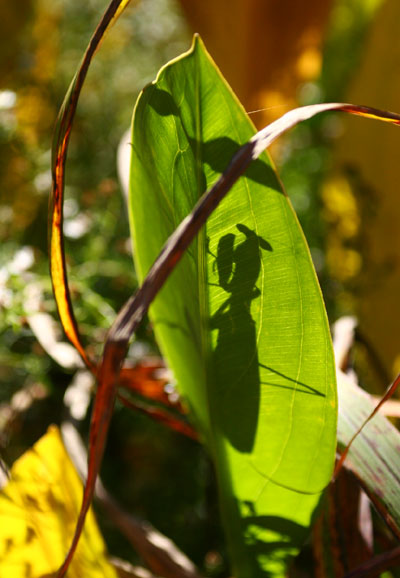 So when I spotted the shadow on the large leaf in passing, you know I was chuffed. Not an hour earlier I had been thinking that the mantids had been scarce in the garden that year, and I lost my opportunities for those shots at home back in July; it was very cooperative of this one to pose so distinctly in the center of the leaf, probably still warming herself after the crisp night. While my framing here makes it quite prominent, this was actually found in a crowded, complicated stand of various plants and was not obvious; I almost missed it entirely in passing. Interestingly, the light angle is not as it seems, as is indicated by by looking at the top right of the leaf, above the crossing brown frond; that thread sticking out up there is her antenna, the same one throwing the fine shadow across the leaf.
So when I spotted the shadow on the large leaf in passing, you know I was chuffed. Not an hour earlier I had been thinking that the mantids had been scarce in the garden that year, and I lost my opportunities for those shots at home back in July; it was very cooperative of this one to pose so distinctly in the center of the leaf, probably still warming herself after the crisp night. While my framing here makes it quite prominent, this was actually found in a crowded, complicated stand of various plants and was not obvious; I almost missed it entirely in passing. Interestingly, the light angle is not as it seems, as is indicated by by looking at the top right of the leaf, above the crossing brown frond; that thread sticking out up there is her antenna, the same one throwing the fine shadow across the leaf.
There was an extensive elementary school group visiting both the garden and the trails the entire time I was there, rather obvious from the noise levels, screams of discoveries echoing off the hills. One small cluster wasn’t too far away when I found the mantis, and I debated about pointing it out to them, but I’m always a bit wary of such things, since younger kids are notoriously bad about observing within disturbing or interfering – sometimes I think it’s better when they haven’t spotted such things on their own, because it tells me they’re not in the appropriate frame of mind for them anyway. This all sounds rather dismissive of children, I know, which isn’t entirely accurate, since I do presentations to kids and enjoy the opportunities to share information and discoveries. But to me, there’s a certain level of focus and respect I’d like to see in place before introducing them to something delicate, just as much as anyone would want to see before letting the kids carry the good china out to the table, you know? Regardless, the group moved on before I had decided which way I was leaning.
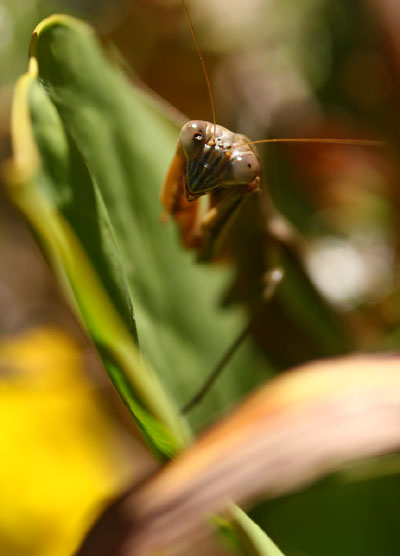 No, I did not get multiple frames of the mantis shadow and neglect getting the mantis herself (I just had some space to fill up alongside.) This is, most likely, a Chinese mantis (Tenodera aridifolia sinensis,) the most common species around here, and the largest – this one is not quite as long as my hand, and I’m guessing female from the size and girth. Yes, she’s got some kind of injury to her right eye cluster, and in a less-than-ideal location too, since it quite possibly affects her depth-perception right up front where it’s most useful in nabbing prey. Yet she’s more than big enough, so either it’s recent or it didn’t have too detrimental an affect on her. Unless I miss my guess she’ll be producing an egg sac soon, which will overwinter and hatch out the young somewhere around early April; she will die off soon afterward. While it might seem odd to us, many species live long enough to reproduce, and not much beyond that – that’s really all that was necessary to pass on the genes, so that’s all that was selected for. We (well, not all of us) give birth to these helpless, floppy little blobs, so we have to stick around long enough to ensure that the genes make it past weaning at least. Yeah, I know, there I go off on the kids again…
No, I did not get multiple frames of the mantis shadow and neglect getting the mantis herself (I just had some space to fill up alongside.) This is, most likely, a Chinese mantis (Tenodera aridifolia sinensis,) the most common species around here, and the largest – this one is not quite as long as my hand, and I’m guessing female from the size and girth. Yes, she’s got some kind of injury to her right eye cluster, and in a less-than-ideal location too, since it quite possibly affects her depth-perception right up front where it’s most useful in nabbing prey. Yet she’s more than big enough, so either it’s recent or it didn’t have too detrimental an affect on her. Unless I miss my guess she’ll be producing an egg sac soon, which will overwinter and hatch out the young somewhere around early April; she will die off soon afterward. While it might seem odd to us, many species live long enough to reproduce, and not much beyond that – that’s really all that was necessary to pass on the genes, so that’s all that was selected for. We (well, not all of us) give birth to these helpless, floppy little blobs, so we have to stick around long enough to ensure that the genes make it past weaning at least. Yeah, I know, there I go off on the kids again…
I have a few more images from the day that may make it to another post, and of course the autumn colors will be progressing, so something more will be along soon enough. You know where to find me.




















































